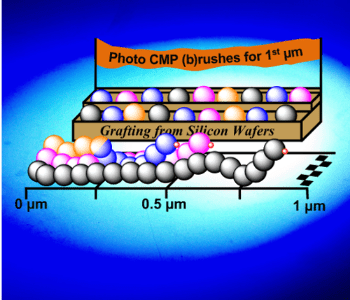 Modification of surfaces by grafting polymer chains from surface-anchored initiators opens vast opportunities to engineer surface properties of materials and is hence an intensely used process. Often, polymer chains are grown via reversible deactivation radical polymerization (RDRP) techniques due to the broad availability of monomers and chemical functionalities. Recently, photo-induced polymerization techniques regained significant attention, giving access to temporal-spatial control which can be used to produce complex surface patterns on a broad variety of substrates.
Modification of surfaces by grafting polymer chains from surface-anchored initiators opens vast opportunities to engineer surface properties of materials and is hence an intensely used process. Often, polymer chains are grown via reversible deactivation radical polymerization (RDRP) techniques due to the broad availability of monomers and chemical functionalities. Recently, photo-induced polymerization techniques regained significant attention, giving access to temporal-spatial control which can be used to produce complex surface patterns on a broad variety of substrates.
In their recent work, the groups of Barner-Kowollik (KIT Karlsruhe), Rodriguez-Emmenegger (Academy of Sciences of the Czech Republic, Prague) and Junkers (Hasselt University) employ the surface-initiated photo-induced copper-mediated radical polymerization (photoCMP) to graft a wide range of polyacrylate brushes from silicon at extremely low catalyst concentrations. PhotoCMP is a relatively new polymerization technique that has already been shown to be highly robust with respect to livingness and control over macromolecular structures.
Application of photoCMP to surface-initiated photo-patterning not only allows for block copolymer formation (demonstrating the high livingness of the surface-confined reaction) and successful re-initiation (temporal control), but also for good spatial control. Most interestingly, photoCMP also allows for very fast modifications and very high polymer film thicknesses, even when only trace amounts of copper catalyst are employed. Surface-initiated photoCMP yields films with thicknesses close to 1 µm within a reaction time of only one hour. At the same time, the surface grafting can be performed with catalyst loadings below 1 ppb, which is unmatched by any other copper-catalyzed RDRP method.

















